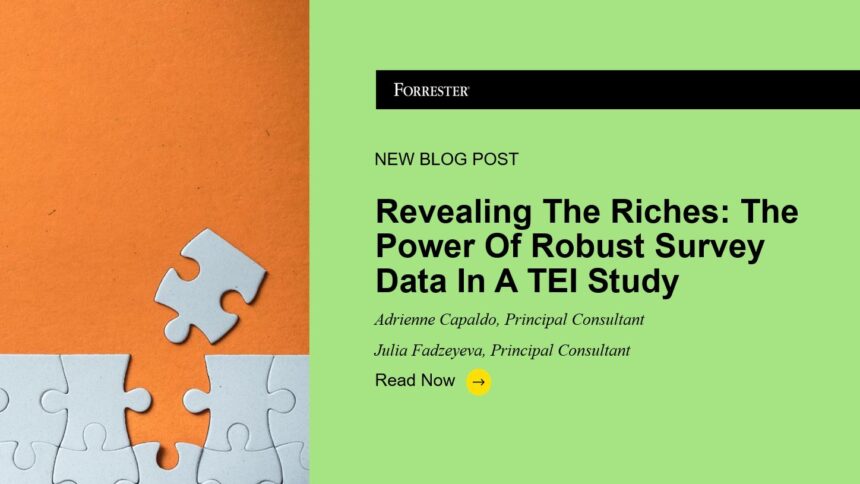Many activities had a renaissance moment during the pandemic: drive-in movies, nature walks, outdoor dining, picnics, and one of our favorites: puzzles. Like any adventure, puzzles challenge us. There’s an adrenaline rush to finally placing that piece that you couldn’t find for the last 2 hours and another when you see begin to see the image slowly come together. And there’s nothing like that sense of accomplishment when you finally complete a puzzle.
As Total Economic Impact™ (TEI) consultants, we build business value case studies from our analysis of customer data. Data is essentially raw material, akin to countless puzzle pieces; it’s our job to carefully assemble the value impact story and unveil the bigger picture, illuminate patterns and trends, and develop understanding that was previously hidden in the chaos.
Studies that leverage surveys:
- Allow readers to zoom in on specific audiences. Surveys can enhance interview findings by validating them for specific use cases, industries, or company sizes. By allowing you to zoom in on specific audiences, survey data can help tell a substory within the TEI. For example, a global manufacturer commissioned a TEI that it intended to use across multiple markets, and their French colleagues were adamant that to be relevant to their prospects, the TEI had to include findings specific to France. With a survey conducted in several European markets, the Forrester team was able to create country-specific callouts and derivative assets to satisfy the local team’s needs.
- Speak to different buyer personas. As buying groups grow, the additional insights can speak to the perspectives and needs of multiple influencers and champions. Not all personas will care about the same criteria, and stakeholders will need buy-in from others to drive consensus. One educational technology company used survey data to differentiate the impact its product had on school administrators, educators, parents, and students, which resulted in a TEI with a broader reach and that spoke to several buyer and decision-maker personas within the edtech space.
- Enrich the narrative. Forrester clients use surveys to better understand the current marketplace and attitudes, trends, and behaviors around a given technology. When clients commission a TEI study, it usually includes at least four customer interviews, which provide a wonderful way to deeply understand benefits, costs, risks and future-state flexibility — but they do not give us a high-level market picture. Surveys allow us to gather rich data about broader industry context, challenges customers are experiencing, their goals for a technology, or factors that influence their purchasing decisions, all at a larger scale.
- Repeat as necessary. Just as a puzzle can be completed over and over, so too can a survey. Forrester offers the ability to refresh TEI studies; however, it’s sometimes difficult to find the same customers to re-interview. People move from job to job more frequently now and may not be available for a study refresh. Surveys, however, are more stable. It’s easy to repeat annually and compare data points and impact. A major collaboration and productivity software provider conducts repeat surveys as a part of its TEI refresh initiative to capture shifts in customer sentiment over time. The surveys are updated to reflect changes in product features and capabilities and provide a valuable source of insights to the software provider’s team.
- Make your study more engaging. Survey charts add detail and color to TEI studies, enhancing interest and the opportunity for dynamic engagement for the reader. They also underscore and visualize trends, adding credibility to the numbers.
Our survey team loves working with clients to add quantitative data to TEI studies. Let us know if you think it’s the missing puzzle piece you’ve been looking for.








